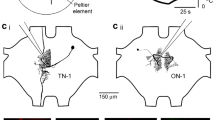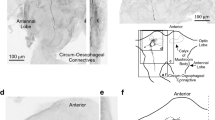Summary
-
1.
In the cricket,Teleogryllus oceanicns, an identified auditory interneuron, interneuron-1 (int-1), is described morphologically and physiologically (Figs. 1,2). There is one such neuron in each hemiganglion of the prothoracic ganglion. The medial dendrites of int-1 overlap part of the terminal field formed by the auditory afferent axons from the ear and int-1's axon ascends to the brain, terminating on the same (ipsilateral) side (Fig- 2).
-
2.
The neuron has a two-part frequency response characteristic: (1) its spontaneous activity is suppressed by low frequencies (3 to 8 kHz) at threshold-to-moderate intensities (Fig. 9 B), and (2) it is strongly excited at high frequencies, especially ultrasonic, from 15–100 kHz (Fig. 3).
-
3.
Int-1 produces more spikes per tone pulse (Fig. 4) and its reponse latency decreases (Fig. 5), with increasing levels of intensity when stimulated by ultrasound.
-
4.
Two-tone inhibition occurs in int-1. When a 30 kHz (normally excitatory) tone is combined with a 5 kHz tone (which suppresses spontaneous activity), the combination tone results in a diminished response, compared to the response to the excitatory tone alone (Fig. 6).
-
5.
The excitation of int-1 shows lateralization. Excitation is stronger in the neuron ipsilateral to the sound source, than in the contralateral int-1 (Fig. 9).
-
6.
Int-1 responds to electronically-generated pulse trains that simulate bat-echolocation signals. The neuron is responsive to a range of ultrasonic frequencies that are contained in the echolocation signals of insectivorous bats (Fig. 11).
-
7.
In light of its response characteristics, we speculate that int-1 plays a role in the detection of ultrasonic signals emitted in the cricket's normal environment by hunting bats.
Similar content being viewed by others
Abbreviations
- int-1 :
-
interneuron-1
- pps :
-
pulses/s
References
Alexander RD (1967) Acoustical communication in arthropods. Annu Rev Entomol 12:495–526
Boyan GS (1981) Two-tone suppression of an auditory neuron in the brain of the cricket: proposed role in phonotactic behavior. J Comp Physiol 144:117–126
Boyan GS, Williams JLD (1982) Auditory neurons in the brain of the cricketGryllus bimaculatus (DeGeer): ascending interneurones. J Insect Physiol 28:493–502
Casaday GB, Hoy RR (1977) Auditory interneurons in the cricketTeleogryllus oceanicus: Physiological and anatomical properties. J Comp Physiol 121:1–13
Eibl E, Huber F (1979) Central projections of tibial sensory fibers within the three thoracic ganglia of crickets. Zoomorphology 92:1–17
Esch H, Huber F, Wohlers D (1980) Physiological and anatomical properties of sensory auditory fibers in crickets,Gryllus bimaculatus DeGeer,Gryllus campestris L. J Comp Physiol 137:27–38
Elsner N, Popov AV (1978) Neuroethology of acoustic communication. Adv Insect Physiol 13:229–355
Griffin DR (1974) Listening in the dark. Dover, New York
Hill KG (1974) Carrier frequency as a factor in the phonotactic behavior of female crickets (Teleogryllus commodus). J Comp Physio 193:7–18
Hill KG, Loftus-Hills JJ, Gartside DF (1972) Pre-mating isolation between the Australian field cricketsTeleogryllus commodus andT. oceaniens (Orthoptera: Gryllidae). Aust J Zoo 120:153–163
Hoy RR (1978) Acoustic communication in crickets: a model system for the study of feature detection. Fed Proc 37:2316–2323
Hoy RR, Casaday GC (1976) Physiological and anatomical properties of cricket auditory interneurons. Soc Neurosci Abstr 2:347
Hoy RR, Paul RC (1973) Genetic control of song specificity in crickets. Science 180:82–83
Hoy RR, Rollins S, Casaday G (1978) Absence of auditory afferents alters the growth pattern of an identified auditory interneuron. Soc Neurosci Abstr 4
Huber F (1962) Central nervous control of sound production in crickets and some speculations on its evolution. Evolution 16:429–442
Huber F (1963) The role of the central nervous system in Orthoptera during the co-ordination and control of stridulation. In: Busnel RD (ed) Acoustic behavior of animals. Elsevier, Amsterdam, pp 440–488
Huber F (1975) Sensory and neuronal mechanisms underlying acoustic communication in orthopteran insects. In: Galun R, Hillman P, Parnis I, Werman R (eds) Sensory physiology and behavior. Plenum, New York, pp 55–97
Huber F (1978) The insect nervous system and insect behavior. Anim Behav 26:969–981
Iles JF, Mulloney B (1971) Procion yellow staining of cockroach motorneurons without the use of microelectrodes. Brain Res 30:397–400
Kalmring K (1975) The afferent auditory pathway in the ventral nerve cord ofLocusta migratoria (Acrididae). J Comp Physiol 104:103–141
Kien J (1976) A preliminary report on cobalt sulfide staining of locust visual interneurons through extracellular electrodes. Brain Res 109:158–164
Miller LA (1975) The behavior of flying green lacewings,Chrysopa camea, in the presence of ultrasound. J Insect Physiol 21:205–219
Moiseff A (1980) Auditory interneurons and phonotactic behavior in the Australian field cricket,Teleogryllus oceaniens. PhD dissertation, Cornell University, Ithaca (New York)
Moiseff A, Hoy RR (1979) Frequency dependent response properties of an identified interneuron in the cricketTeleogryllus oceaniens. Soc Neurosci Abstr 4:255
Moiseff A, Pollack GS, Hoy RR (1978) Steering responses of flying crickets to sound and ultrasound: mate attraction and predator avoidance. Proc Natl Acad Sci USA 75:4052–4056
Oldfield BP (1980) Accuracy of orientation in female crickets,Teleogryllus oceaniens (Gryllidae): dependence on song spectrum. J Comp Physiol 141:93–99
Pitman RM, Tweedle CD, Cohen MJ (1972) Branching of central neurons, intracellular cobalt injection for light and electron microscopy. Science 176:412–414
Pollack GS, Hoy RR (1979) Temporal pattern as a cue for species-specific calling song recognition in crickets. Science 204:429–432
Pollack GS, Hoy RR (1981) Phonotaxis in flying crickets: neural correlates. J Insect Physiol 27:41–45
Popov AV, Markovich AM (1982) Auditory interneurones in the prothoracic ganglion of the cricket,Gryllus bimaculatus II. A high-frequency ascending neurone (HF1AN). J Comp Physiol 146:351–359
Popov AV, Shuvalov VF (1977) Phonotactic behavior of crickets. J Comp Physiol 119:111–126
Popov AV, Markovich AM, Andjan AS (1978) Auditory interneurons in the prothoracic ganglion of the cricket,Gryllus bimaculatus deGeer. J Comp Physiol 126:183–192
Popov AV, Shuvalov VF, Markovich AM (1975) Spectrum of the calling songs, phonotaxis and the auditory system in the cricketGryllus bimaculatus. J Evol Biochem Physiol 2:453–460
Regen J (1913) Über die Anlockung des Weibchens vonGryllus campestris L. durch telephonisch übertragene Stridulationslaute des Männchens. Pflügers Arch 155:193–200
Rehbein H, Kalmring K, Römer H (1974) Structure and function of acoustic neurons in the thoracic ventral nerve cord ofLocusta migratoria (Acrididae). J Comp Physiol 95:263–280
Rheinlaender J, Kalmring K, Popov AV, Rehbein H (1976) Brain projections and information processing of biologically significant sounds by two large ventral-cord neurons ofGryllus bimaculatus DeGeer. J Comp Physiol 110:251–269
Roeder KD (1967) Nerve cells and insect behavior. Harvard University Press, Cambridge
Sachs M, Kiang N (1968) Two-tone inhibition in auditory nerve fibers. J Acoust Soc Am 43:1120–1128
Shuvalov VF, Popov AV (1971) Reaction of flying females of the domestic cricket,Acheta domesticus to sound signals and its changes in ontogenesis. J Evol Physiol Biochem 7:612–616
Stewart WW (1978) Functional connections between cells as revealed by dye-coupling with a highly fluorescent naphthalimide tracer. Cell 14:741–759
Suga N (1968) Neural responses to sound in a Brazilian mole cricket. J Audit Res 8:129–134
Thorson J, Weber T,- Huber F (1982) Auditory behavior of the cricket. II. Simplicity of the calling-song recognition inGryllus, and anomalous phonotaxis at abnormal carrier frequencies. J Comp Physiol 146:361–378
Tyrer NM, Bell EM (1974) The intensification of cobalt-filled profiles using a modification of Timm's sulfide-silver method. Brain Res 73:151–155
Ulagaraj SM, Walker TJ (1973) Phonotaxis of crickets in flight: attraction of male and female crickets to male calling songs. Science 182:1278–1279
Walker TJ (1957) Specificity in the response of female tree crickets (Orthoptera, Gryllidae, Oecanthinae) to calling songs of the males. Ann Entomol Soc Am 50:626–636
Weber T, Thorson J, Huber F (1981) Auditory behavior of the cricket. I. Dynamics of compensated walking and discrimination paradigms on the Kramer treadmill. J Comp Physiol 141:215–232
Wohlers DW, Huber F (1978) Intracellular recording and staining of cricket auditory interneurons. J Comp Physiol 127:11–28
Wohlers DW, Huber F (1982) Processing of sound signals by six types of neurons in the prothoracic ganglion of the cricket,Gryllus bimaculatus L. J Comp Physiol 146:161–173
Zaretsky MD (1972) Specificity of the calling song and short term changes in the phonotactic response by female crickets (Scapsipedus marginatus) (Gryllidae). J Comp Physiol 79:153–172
Author information
Authors and Affiliations
Rights and permissions
About this article
Cite this article
Moiseff, A., Hoy, R. Sensitivity to ultrasound in an identified auditory interneuron in the cricket: a possible neural link to phonotactic behavior. J. Comp. Physiol. 152, 155–167 (1983). https://doi.org/10.1007/BF00611181
Accepted:
Issue Date:
DOI: https://doi.org/10.1007/BF00611181




